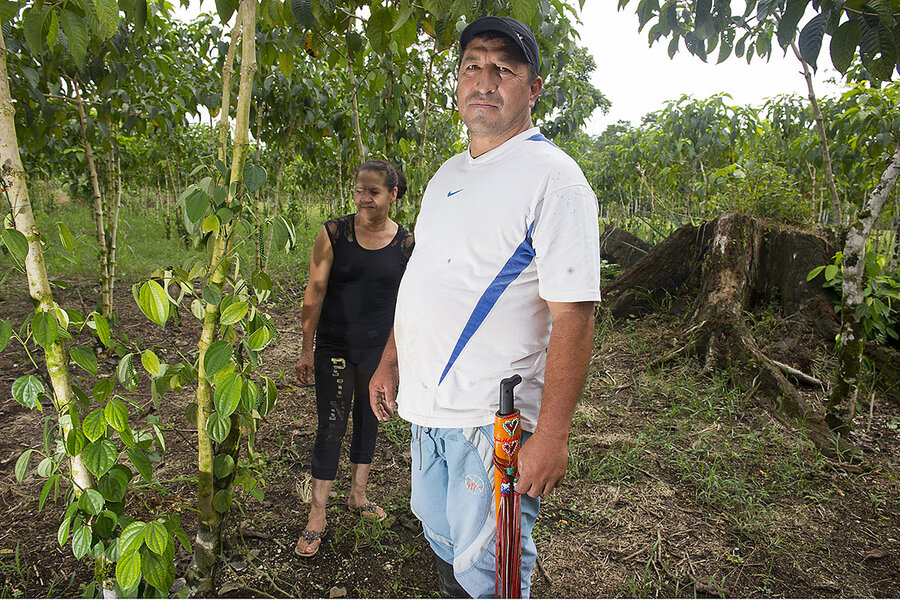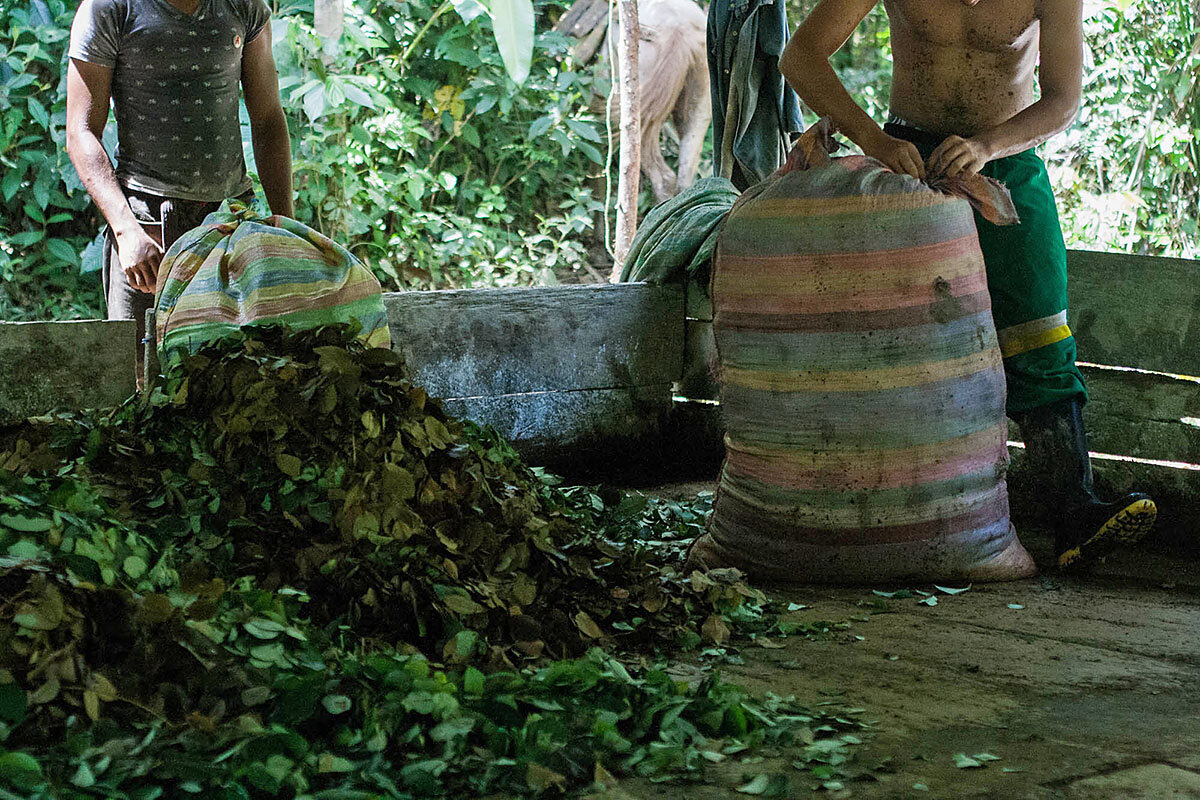Ditching coca for other crops, Colombia's farmers ask: Where do we sell?
Loading...
| La Carmelita, Putumayo, Colombia
By the time he made it to the final booth at the open-air community center in this small Amazonian town, Rafael Pardo, Colombia’s high commissioner for post-conflict, human rights, and security, was loaded up with more produce than he could carry.
Melon, yucca, sugar cane, black pepper, pineapple, cacao, ground corn, squishy white campesino (peasant farmer) cheese – a healthy sampling of the rich agrarian potential the government hopes to foster in the impoverished, war-torn countryside. For years, the economy in states like Putumayo, near the Ecuadorean border, revolved almost exclusively around a single crop: coca, used to make cocaine. But the government is trying to change that, capitalizing on recent peace accords to end decades of drug-fueled conflict.
“Here, there’s obviously no shortage of options going forward,” Mr. Pardo says at the event, which La Carmelita residents organized to mark the start of a local coca substitution program. It’s one of five national pilots launched as part of Colombia’s historic 2016 peace accord between the administration of Nobel peace laureate President Juan Manuel Santos and the Revolutionary Armed Forces of Colombia (FARC).
But, Mr. Prado says, “It’s not what the soil can produce so much as what the producer can sell.”
For decades, the FARC used revenue from the booming Colombian coca trade to finance its fight with the government. Now the rebels, who completed their transition to a civilian political movement last week, are cooperating with state officials to establish an institutional presence in their former strongholds: police stations, hospitals, even banks. It’s an opportunity to heal a fragmented nation – and a high-stakes test of a government long characterized as ineffective and corrupt.
Since May, some 75,000 coca-farming families across Colombia have volunteered for a two-year crop substitution program outlined in the FARC peace deal. The program, which doles out food subsidies and technical assistance to participating campesinos, could expand to include as many as 100,000 additional families, according to the presidential task force.
Once it’s persuaded them leave the relatively lucrative crop behind, however, the government has to ensure the necessary conditions for viable alternatives. That means building new infrastructure, improving basic public services like education, and targeting the root causes of rural poverty, violence, and political exclusion that preceded Colombia’s half-century armed conflict with the FARC.
“The state has totally abandoned its responsibilities in Putumayo,” says Yuri Quintero, a departmental assemblywoman from La Carmelita. “And that negligence is not something that can be overcome in months or even years.”
Looking beyond the harvest
Building infrastructure – from roads and bridges, to schools and hospitals – will be key to Colombia’s success in creating lasting peace, locals say.
“These are, for the most part, fertile lands,” says local farmer Jesús Antonio Toro de Martínez. “You can grow whatever you want. That’s not the problem.” The problem is what happens once you’ve harvested, he says.
Behind his stilted wooden ranch house, past the duck coop, bamboo cattle pen, and murky tilapia fish pond, Toro is uprooting the last few coca bushes growing wild amid his plantain and papaya orchard.
He thought he’d removed the last of the coca in 2002, when he first bought the 2.5-acre farm from a friend. Worn out by his youthful hedonism and weary of Putumayo’s escalating dirty war – in which guerrillas, right-wing paramilitaries, and public officials alike all drew from the drug trade – he decided that coca “just wasn’t worth the trouble.”
Ahead of a UN inspection in July, he gladly ripped up the patch of native, chest-high coca bushes that had survived at the back of his property.
Mr. Toro is, in many ways, a model for what coca substitution hopes to accomplish. A trained, if unlicensed, veterinarian who grew up around livestock and subsistence crops on his grandmother’s farm, he offers affordable medical services to ranchers and started a local agrarian association to encourage legal farming.
But his experience doing things “the right way” has left him as skeptical as he is hopeful.
How, he wonders, will farmers process value-added foodstuffs without equipment, technical training, and reliable electricity? How will they keep produce from spoiling in the sweltering Amazonian humidity? While government geographers are busy surveying future infrastructure projects, how are farmers supposed to get shipments to market over muddy jungle trails and unbridged rivers? And what happens, once they get them there, if there is no market to begin with?
“There’s not enough money nor demand in this region to sustain a productive economy,” says Toro. “Especially if, from one day to the next, everybody starts selling limes instead of coca.
“What worries me is that, in all those meetings [the government has] held, they’ve never talked about how we’re going to commercialize our goods,” Toro says. “Without commerce, we don’t have anything.”
History lesson
One reason for caution is Plan Colombia, the US-backed counternarcotics and counterinsurgency offensive launched in 2000. Government officials made similar promises about coca replacement and social support then, allocating tens of millions of dollars for “alternative development” in Putumayo. But residents say the money never reached them, or that early substitution efforts were canceled out by aggressive chemical eradication campaigns that harmed their new crops. And, while coca production had dropped in recent years, it has shot back up recently, to levels last seen when Plan Colombia was getting off the ground.
“There is great distrust, on both sides,” says Miguel Ortega, the government’s representative for substitution programs in Putumayo. “We’re aware that that is a significant challenge that has to be overcome.”
Mr. Ortega insists that officials have learned the lessons of Plan Colombia, pointing to a the new program’s collaborative, community-led design and transparency.
FARC’s active participation is also seen as crucial to securing much-needed community buy-in.
“As a political movement, we are committed to ensuring that communities that have been obligated, due to their material conditions, to resort to criminalized means of survival [now] enjoy all the opportunities they deserve,” says a rebel commander who goes by the alias “Norbey,” previously in charge of FARC’s 48th Front.
A formidable fighting force, the Putumayo-based 48th Front was one of many units tasked with filling the rebels’ coffers with revenue from coca production “taxes” and semi-processed cocaine paste. Norbey says he has shared extensive intelligence with newly formed government teams assigned to pursuing right-wing criminal gangs aiming to take control of former FARC territories.
Providing 'basic needs'
But the peaceful future of communities like La Carmelita will depend on even more than viable markets and sturdy bridges.
On a recent afternoon, 15-year-old Yeni Alejandra stands in the middle of La Carmelita’s lone highway, holding a homemade sign. After regularly being dismissed from school two-and-a-half hours early, she’s protesting alongside a few hundred other students, teachers, and parents, calling for schools to “give us more class.”
“My goals, my dreams, all depend on my studies,” says Yeni.
Putumayo is one of the poorest departments in Colombia, and has just one public institute of higher education, a vocational school. Students, who commute hours on foot, by donkey, and sometimes by speedboat, struggle to make it to the chronically underfunded grade schools.
Last year, activists and community leaders successfully lobbied the departmental and national government to adopt a 10-year development strategy for Putumayo. Like the coca substitution program, the plan includes a series of long-term investments in infrastructure, health care, and education.
But a global drop in oil prices has pushed Bogotá toward austerity. And mounting political pressure to reduce coca cultivation means that there’s more focus on short-term success eradicating coca plants at the expense of long-term investment, according to a recent report from the Ideas for Peace Foundation, a Colombian think tank.
“We have to acknowledge that coca provided a lot of basic needs that the government didn’t,” says Ms. Quintero, the local assemblywoman.
“If the government isn’t willing or ready to fulfill its obligations, then people are going to go back to what they feel is safe.”







